While Ellen Rothenberg works in a range of scale and material, there is a tactile quality to her work–a directness that calls attention to the body. I always think of organic bodies, bodies that don’t recognize an essential authority in our human structures. Like a climbing vine or water, her work seems to stretch through and around expectations. There are cracks in the street where weeds grow. The roof boasts an almost mystical, wandering leak. Ellen investigates literal and psychological structures, delving into the tension between what we take for granted and what has been overlooked. She activates the porousness of an assumption, nestling into its marginalized areas in order to produce new, self-reflexive spaces.
Caroline Picard: I was wondering if you could talk a little bit about your background.
Ellen Rothenberg: I was born in NYC and grew up in and around the NY metropolitan area. My parents were both engaged in progressive politics and the arts. My mother was a painter and my father a director of television commercials, industrial films, and documentaries. They were involved with leftist politics, the civil rights and the anti-war movement. I guess you could say I’m a classic red-diaper baby. My father helped to integrate the film production unions in NY and during the McCarthy era, he employed many blacklisted actors who were under investigation by the House Un-American Activities Committee. It was this mix of urbanism, politics, and the arts that was influential on my own development as an artist.
As a teenager, I took drawing classes at the Art Students League and went on to Cornell University’s College of Art and Architecture and later studied Massachusetts College of Art in Boston, the only state supported art school in the country. I lived and worked in Boston before moving to Chicago.
CP: How does a new project occur to you? Is it a consistent process? Is it easy? Do you always work in the same way?
ER: Projects occur in different ways; I’m not sure about consistency. Sometimes, like in Stealth, ideas occur in relation to events — in this case the wars in Afghanistan and Iraq. It was the discrepancy between the abstracted satellite and smart bomb images of landscapes and “facilities” transmitted on the news, against the images from the ground of refugees and the violence, which triggered the project. Stealth was also my attempt to acknowledge and address the distance between these events and daily life in the US.
As the wars progressed, I also began to notice the infiltration of militarization into life in the States. This produced some strange material anomalies like pink camouflage baby pajamas or camouflage patterned bikinis! For more formal research into camouflage, I arranged to visit the Natick Soldier Systems Center, a Department of Defense installation responsible for technology development and engineering of US military food, clothing, shelters, airdrop systems, and soldier support. I met with a member of the Materials and Systems Integration Team, the group that develops and tests camouflage for the US military. The visit ended with a strange doubling back to artmaking, when a product engineer asked about Mondrian and Seurat and what they had to do with camouflage. Later we had an exchange. I sent him books on the artists and he forwarded samples of ‘failed’ camouflage patterns, which I later incorporated into Stealth.
At other times, the inception of a project is accidental. The Anne Frank Project began with “The Critical Edition of the Anne Frank Diary,” published by The Netherlands Institute for War Documentation, which I had bought to give as a gift and the accidental meeting with Dienke Hondius, an activist working at The Anne Frank Museum in Amsterdam, which coincided with a year[long] residency in Berlin. Travel often offers beginnings or suggestions for projects.
Sometimes it’s just chance. While I was a fellow at the Bunting Institute at Radcliffe College, I was researching women and labor in the open stacks at The Schlesinger Library for a public sculpture project. I accidentally found a book of National Socialists propaganda images from the 30s of young women’s work organizations, which became the basis of Beautiful Youth, a large sculptural installation. At other moments, it might be invitations to participate in projects or exhibitions with a specific context or focus that might suggest ideas for new work. Often beginnings may be easy but there are often false starts and many dead ends before the work comes together.
CP: I’m interested in how you choose the material you work with–whether that is text, fiber, performance, or installation?
Materials aren’t neutral — they carry meaning along with their histories of production and use. Perhaps this preoccupation with materials is a pre-digital sensibility? I’m interested in the inflection of meaning that occurs through the materials’ specificity. In Berlin this past summer, I exhibited Constellations, an installation which employed 5 and 10 cent store price tags from the 40s. At the gallery the price tags were arranged in loose clusters along with arrow signs indicating direction or possible locations. The work referenced economies – – an economy of scale, of transport (the work could be packed in a small suitcase and brought to Europe in an overhead rack) but most importantly, the work spoke to this moment of global economic crisis and the oblique and often indecipherable relationships between interwoven economic forces that shape our options on the most elemental level… the price of bread. With their archaic prices: 7 cents, 11 cents, 29 cents, 12 for $1.79, the bright red tags with their worn surfaces and minute sums arranged in seeming infinite clusters spoke to me of the indecipherability of the global economic crisis.
I don’t think of performance or installation as a material, but a methodology or a form necessitated by the content of the work.
CP: How do you arrive on a particular scale of working–I feel like you have a pretty significant range, whether its something as large as the Anne Frank Project, or small winking gestures of MCA/East. Maybe another example of ranging scale is evident in your Constellations project, or also the 516 Arts installation this summer?
ER: I’m not sure I knew what I was getting into with the Anne Frank Project; certainly at the beginning there wasn’t the realization that it would be a focus of my work for the next five years. In that case and in many of my larger scale projects: Stealth, Beautiful Youth, even Ecstasy on Arrest, the work starts to accrue in response to a set of questions or ideas and as the research deepens and changes so does the work. That said, there is also the question of support–grants, residencies, or fellowships and how they affect what you’re able to do — for example, to be able to continue working without the distraction of a job. Fellowships can provide access to invaluable resources–to collections, studio space, even project interns, and most importantly, access to a new intellectual community. I’m thinking specifically of my fellowship year at the Bunting Institute at Radcliffe College, currently the Radcliffe Institute. The fellows at that time were all women so it was a feminist community of international scholars, writers, filmmakers, and activists who were engaged with their work in all fields from human rights to mathematics. The energy, focus, and discussion were phenomenal.
Constellations and EAST, the work that appeared in multiple installments at the MCA in Chicago during 2009 – 2010, reflect a very different way of working. Initially both EAST and Constellations were made in response to invitations from arts organizations or project spaces in Europe, which do excellent work but have severe budgetary constraints. So it was important to develop work that would be possible to realize given the minimal funding. These constraints afford a different way of working — quick, experimental, almost improvisational. Here, the emphasis for me is on the opportunity to work in a new context, a different country with another audience. It’s altogether a fresh experience.
Possibilities for Use, the work that was exhibited at 516 Arts in New Mexico this summer, was a bit different than either the large-scale projects or the smaller improvisational works. It was a project that I’d been working off and on for about a year and a half, and the exhibition at 516 Arts was the first context for this new work, which I’m in the process of expanding.
CP: Would you talk a little bit about the reading performance you did at The Albuquerque Museum of Art and at The Hyde Park Art Center? In some way I think about this as a re-enactment of power structures, but then of course, there is a much more immediate gratification (I love being read to, and I think it’s a really interesting way to activate an artspace.)
ER: I also love spoken text and the kind of attention that one brings to listening whether it’s the intimacy of two people reading to one another or to a larger group. Another compelling aspect to incorporating a reading event in an exhibition context is the social space public readings construct. It was through teaching both artists and writers in the Graduate Writing Program at SAIC that I returned to the performance of text as a means of reframing the space of the exhibition.
For the first exhibition of Stealth at Northeastern Illinois University in 2007, I invited friends — artists, poets, and writers — to respond to the work in the exhibition with new texts or to read from works about landscape, geography, and place that they had already written. Their texts reframed the installation and suggested a new multilayered reading of the work. The event undermined the conventions of an art opening and created a dialogic social space. This was appropriate in a time of war with work concerned with the war, however distant geographically the war was to this specific event.
For subsequent group exhibitions — Consuming War in 2008 at The Hyde Park Art Center in Chicago and Experimental Geography in 2009 at The Albuquerque Museum of Art in New Mexico — I organized events involving local writers in both communities to read original works. Both were performance/readings modeled on the tradition of “El Lector,” a reader, collectively paid by fellow workers at cigar factories in Cuba from the late nineteenth century into the twentieth century to read aloud literature, political texts, and the news throughout the workday, while workers listened and rolled cigars. In this case, a team of volunteers made bundles out of re-purposed camouflage clothing while local writers read works that responded to the ideas in the exhibitions. The work of making the bundles was performed in front of the audience and projected along with text fragments from the writers; we were literally folding and rolling language into the sculptures.
CP: I also keep thinking about how your work deals with navigating different power structures–in some way that seems to manifest your approach to a physical and/or institutional space. I was wondering if you could talk about some of your different strategies with that.
ER: In my work, I’m trying to intervene in the normative relation of space. Physical space is often taken for granted and the architectural, authoritative space of the museum also sets up expectations of where art should be seen and located.
One of the strategies I’ve consistently employed is to locate my work outside this zone of expectations. One instance is the Marginal Way, which was included in an exhibition of installations in the Cyclorama in Boston. There were two two-story structures designed as viewing apparatuses built by Kennedy Violich Architects to house the installations. I choose to locate my work, a series of sculptural interventions, in and around these structures. The Marginal Way began at the staircase as you entered the building. I installed a soft banister cover with the embroidered text asking, “can you grasp it?” Working closely with the architects, I installed other elements of the installation in and around the architectural structures, on a balcony, in vitrines, down corridors, in a directory case. So the Marginal Way became a series of markers, a kind of navigational commentary on movement both physical and political.
Another project is The Invisible Garden, which was part of a citywide exhibition pairing twenty-four artists with gardens in Chicago’s public parks. The Invisible Garden was sited in Lincoln Park, a very popular park on the north side of the city across from the Chicago History Museum. My area included a statue of Benjamin Franklin, elevated on a granite pedestal. I intentionally utilized the historic figure of Franklin sited in a highly visible central location to ask the question: “what aren’t we seeing, what surrounds us but remains invisible?” Responses were solicited and collected via the web, and a selection of these text responses were made into banners, installed on scaffolding framing the statue. A large thirty-foot diameter circular garden, designed and planted in a camouflage pattern, encircled the statue. Other elements included convex surveillance mirrors placed in the trees along the path leading to the sculpture. The Invisible Garden mapped a social space, which included skateboarders, running children, and pedestrians. Like Gustav Klucis’s Radio-Orator, Invisible Garden became a broadcast station of the political, social, and personal.
CP: Do you feel like there are expectations for an “artist” in the world? How have you/do you negotiate/d those?
ER: Expectations are directed at artists from both outside and within the art world; the artists’ job is to address and challenge them. Some expectations are historically inflected — during college there was a common assumption that the “real” or “best” artists were men and just working against this assumption was political. One of the most radical acts in my career was to have a child, because family doesn’t figure into most notions of who artists are and how they’re supposed to live. With the relentless, myopic cultural focus on youth and the “new,” just continuing to work as an artist is an ongoing act of resistance.

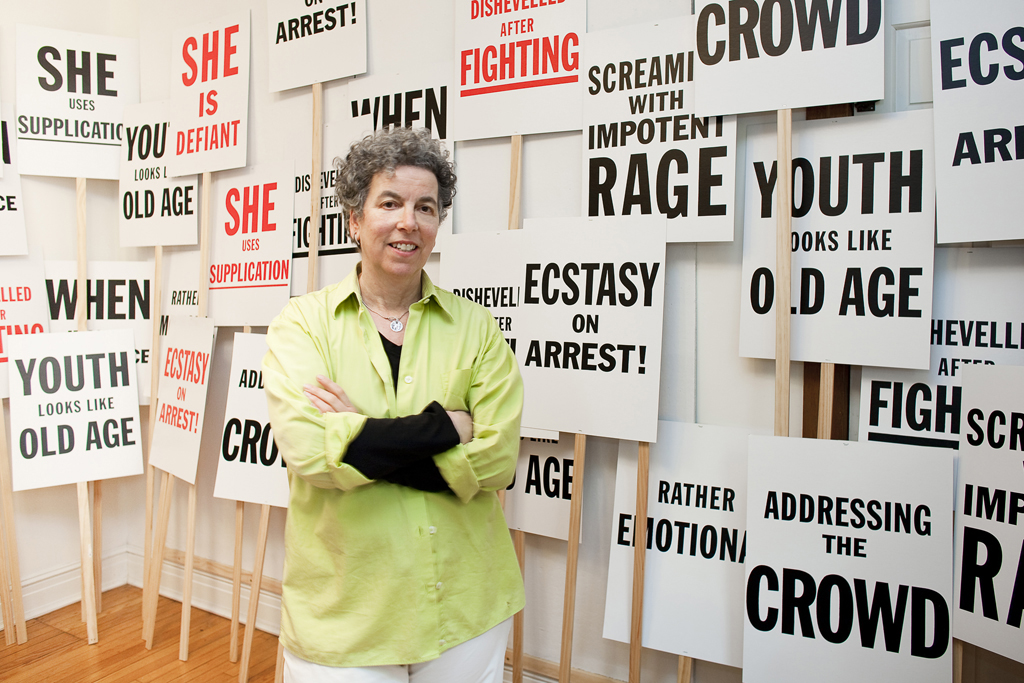
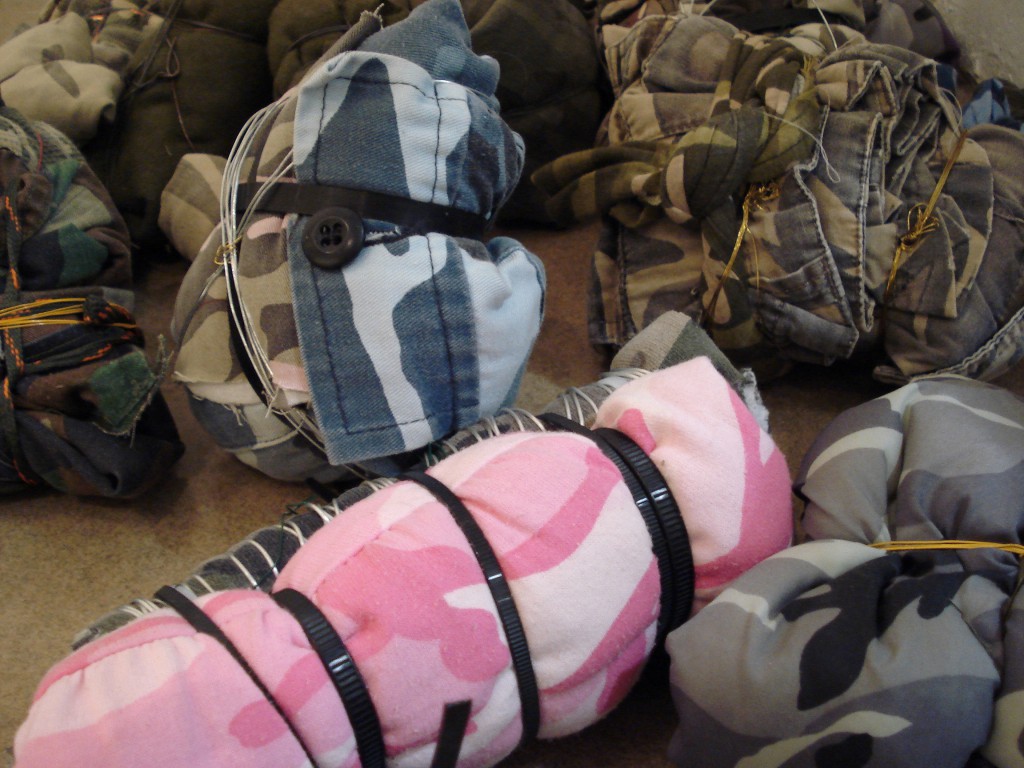
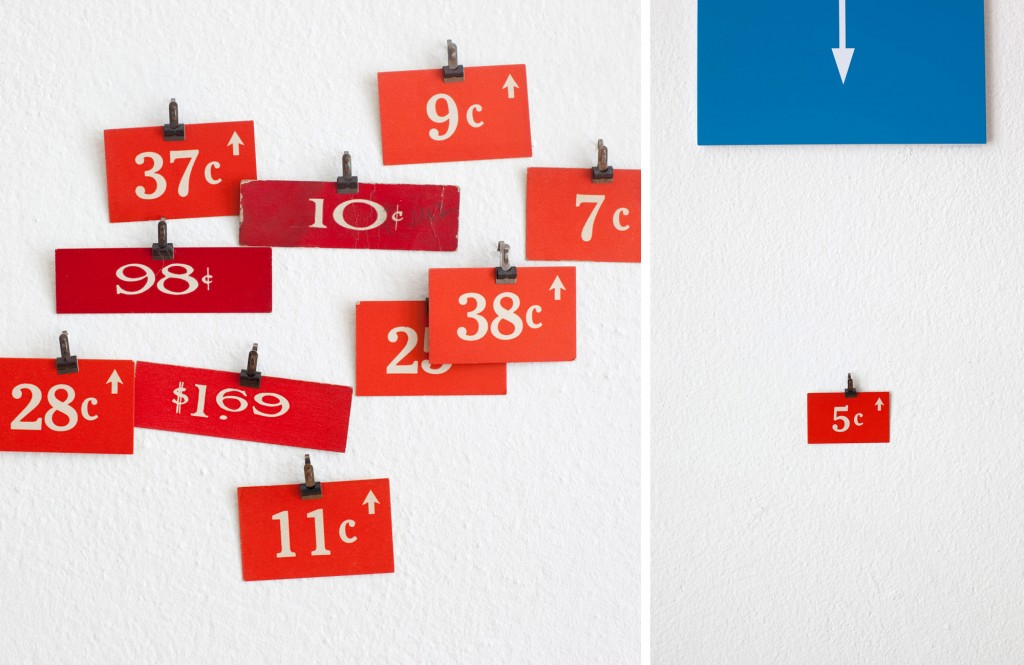
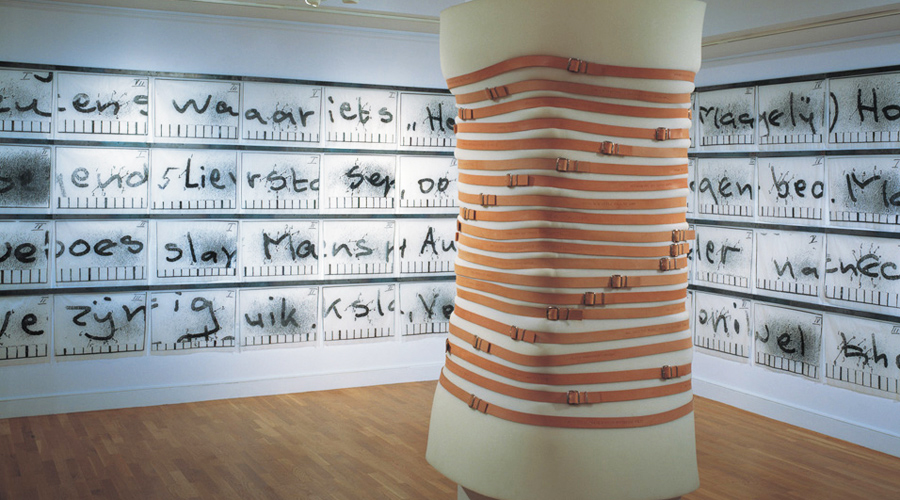
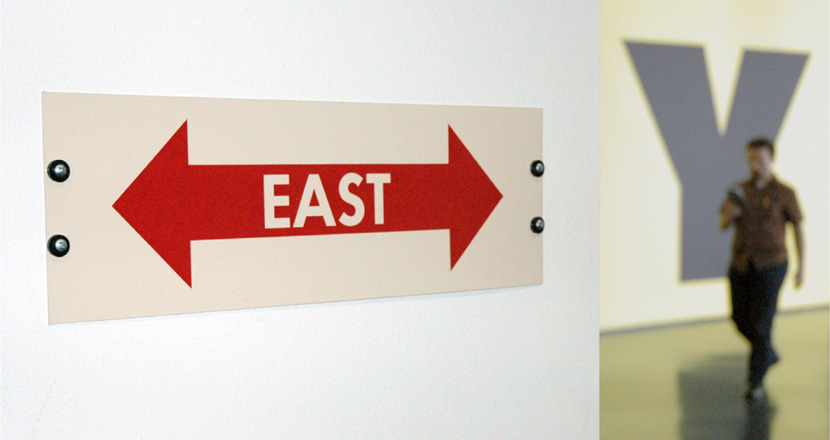
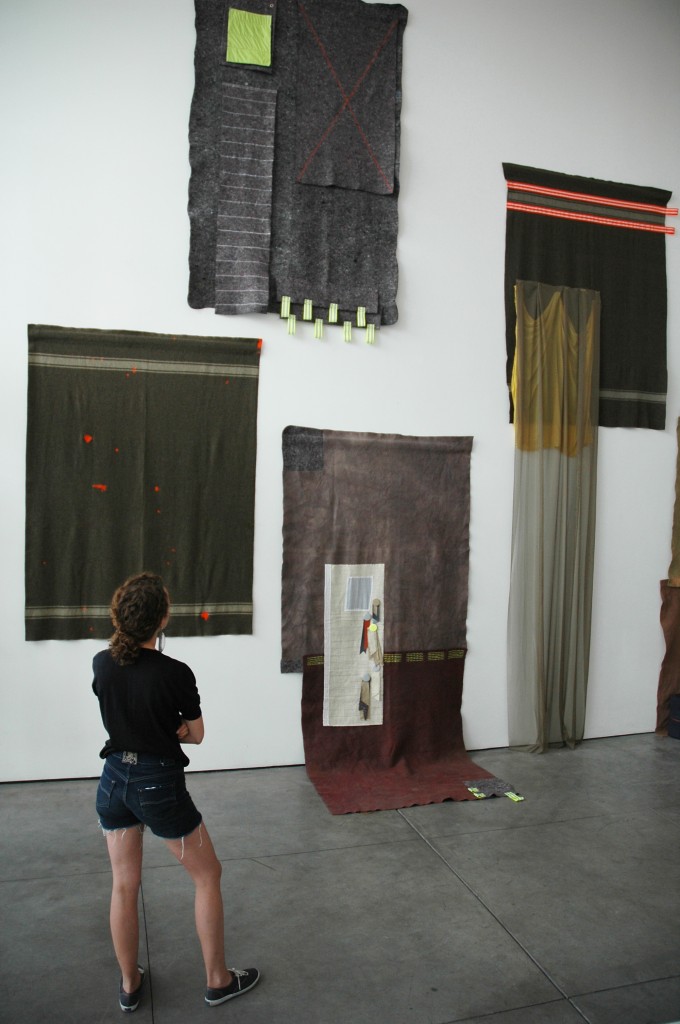

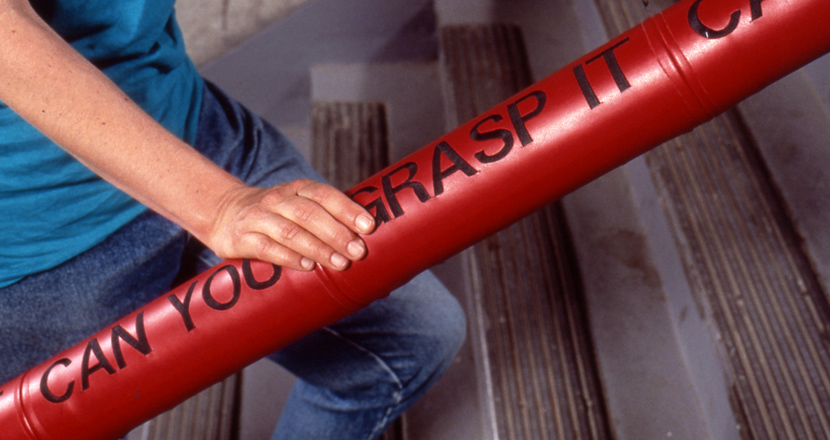
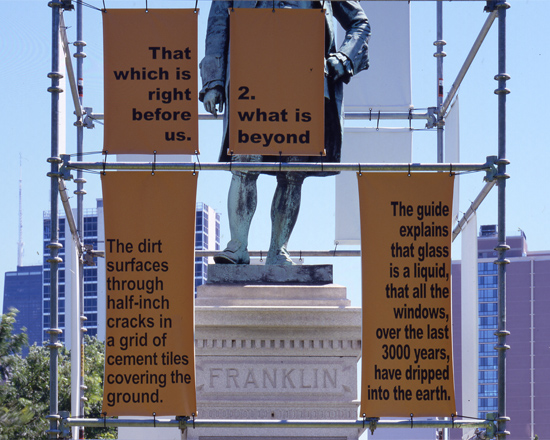



Pingback: Interview with Ellen Rothenberg | The Lantern Daily